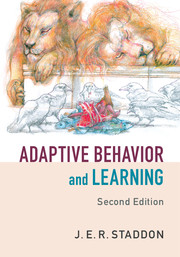Book contents
- Frontmatter
- Contents
- Preface to the second edition
- Acknowledgments
- 1 The evolution, development, and modification of behavior
- 2 Variation and selection: kineses
- 3 Reflexes
- 4 Direct orientation and feedback
- 5 Operant behavior
- 6 Reward and punishment
- 7 Feeding regulation: a model motivational system
- 8 The optimal allocation of behavior
- 9 Choice: dynamics and decision rules
- 10 Foraging and behavioral ecology
- 11 Stimulus control and cognition
- 12 Stimulus control and performance
- 13 Molar laws
- 14 Time and memory, I
- 15 Time and memory, II
- 16 Template learning
- 17 Learning, I
- 18 Models of classical conditioning
- 19 Learning, II
- 20 Learning, III: procedures
- 21 Comparative cognition
- Index
20 - Learning, III: procedures
Published online by Cambridge University Press: 05 March 2016
- Frontmatter
- Contents
- Preface to the second edition
- Acknowledgments
- 1 The evolution, development, and modification of behavior
- 2 Variation and selection: kineses
- 3 Reflexes
- 4 Direct orientation and feedback
- 5 Operant behavior
- 6 Reward and punishment
- 7 Feeding regulation: a model motivational system
- 8 The optimal allocation of behavior
- 9 Choice: dynamics and decision rules
- 10 Foraging and behavioral ecology
- 11 Stimulus control and cognition
- 12 Stimulus control and performance
- 13 Molar laws
- 14 Time and memory, I
- 15 Time and memory, II
- 16 Template learning
- 17 Learning, I
- 18 Models of classical conditioning
- 19 Learning, II
- 20 Learning, III: procedures
- 21 Comparative cognition
- Index
Summary
This chapter analyzes a number of widely used experimental procedures from the point of the principles derived in previous chapters.
Conditioned reinforcement
Conditioned reinforcement is invoked when a response produces a stimulus that signals reinforcement. The signal stimulus is termed a conditioned or secondary reinforcer. How useful is this idea?
There is no doubt that the conditioned reinforcement procedure can act as an aid to memory. I look at that property first. But is a conditioned reinforcer really a reinforcer? Or is there a better way to look at the data? It turns out that relative proximity to the (primary) reinforcer explains most schedule effects usually attributed to conditioned reinforcement.
Acquisition shows what I mean by a memory effect. For example, suppose we attempt to train a pigeon to peck a white key for food reward. The food is available for a peck every 30 sec (say). Food is not delivered immediately, but only after a delay of 5 sec. Even if the animal does occasionally peck the key, the effect of each reward is likely to be small, the bird will obtain little food, and pecks may be few. The likely reason is that it is difficult for the bird to pick out the peck, a brief event preceded and followed by other activities, as the best predictor of food, unless peck and food occur close together in time.
We can make the bird's task much easier by arranging that pecks on the white key are immediately followed by a 5-sec green stimulus ending in (response-independent) food. The time relations between pecking and food are exactly the same as in the original delayed-reward procedure, yet the pigeon will rapidly learn to peck the white key to get the 5-sec of green as a signal. (Since this is an autoshaping procedure, the bird will also peck the green key, but those pecks are not necessary for the effect.)
The two-stimulus procedure is termed a one-link chained schedule: peck → stimulus → food. The schedule in the white stimulus is fixed interval (FI) with production of the green stimulus as the reward; the schedule in green is 5-sec fixed time (FT). The green stimulus is used as a reinforcer and seems to act like one. However, it gains its power not innately but by virtue of its pairing with food. It is thus a conditioned or secondary reinforcer.
Information
- Type
- Chapter
- Information
- Adaptive Behavior and Learning , pp. 532 - 562Publisher: Cambridge University PressPrint publication year: 2016
